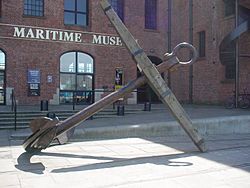International Slavery Museum facts for kids

Main entrance to the museum
|
|
| Established | 23 August 2007 |
|---|---|
| Location | Albert Dock, Liverpool, England, United Kingdom |
| Type | Slavery |
| Visitors | 396,877 (2019) |
The International Slavery Museum is a special museum located in Liverpool, UK. It teaches visitors about the history and lasting effects of the transatlantic slave trade. This museum is part of the Merseyside Maritime Museum. It helps us understand the lives of people in West Africa, how they were enslaved, and their brave fight for freedom. The museum also talks about slavery happening today and important topics like racism and discrimination.
Contents
Museum History and Purpose
How the Museum Started
The story of the slave trade was first shown at the Merseyside Maritime Museum, which opened in 1980. In 1994, a special gallery was created. This gallery focused on the transatlantic slave trade. It also explored Liverpool's important role in this history. A key person who pushed for an international slavery museum was Dorothy Kuya in 1992.
By the early 2000s, many people from around the world visited the exhibition. This showed a great interest in learning more. So, the decision was made to create a museum just for the history of slavery. This new museum would help explain slavery and its lasting impact even better.
Opening and Important Dates
The International Slavery Museum officially opened on August 23, 2007. This date is very important. It marks the annual International Day for the Remembrance of the Slave Trade and its Abolition. This day remembers the start of a major slave uprising in Saint-Domingue.
The year 2007 was also special for another reason. It was 200 years since the UK passed the Slave Trade Act 1807. This law made the slave trade illegal in the British Empire. However, it did not end slavery itself at that time. The new museum doubled the space dedicated to this important subject.
Special Collections and Leadership
The East Gallery at the museum has about 400 songs. These songs tell stories about the experience of slavery. They also feature music from Africa and from people of African descent who were enslaved.
In March 2018, the museum received £50,000. This money was used to buy and restore a painting. The painting is called 'Am Not I A Man and a Brother'. It was made around 1800. The design for this painting came from the Committee for the Abolition of the Slave Trade. This image is thought to be one of the first logos used for a political cause. It was also used on pottery made by Josiah Wedgwood.
In 2023, Michelle Charters was announced as the new Head of the museum.
Future Plans and Renovations
In 2024, plans were announced for big renovations. These plans include connecting the museum to the former Dock Traffic Office. This building is now called the Dr Martin Luther King Jr building. It is right next to the Maritime Museum. The two buildings will be joined by a bridge made of iron and glass.
The museum closed for these renovations at the start of 2025. It is expected to reopen in 2028.
What You Can See at the Museum
The museum has different sections for visitors to explore. One part shows what life and culture were like in West Africa before the transatlantic slave trade began. Other displays cover the full history of slavery. There are also special exhibitions that talk about the lasting effects of slavery. These sections also discuss important human rights issues happening today.
More Places to Learn
- Slavery museum (France)
- Whitney Plantation Historic District (US)
- United States National Slavery Museum (planned, abandoned)

